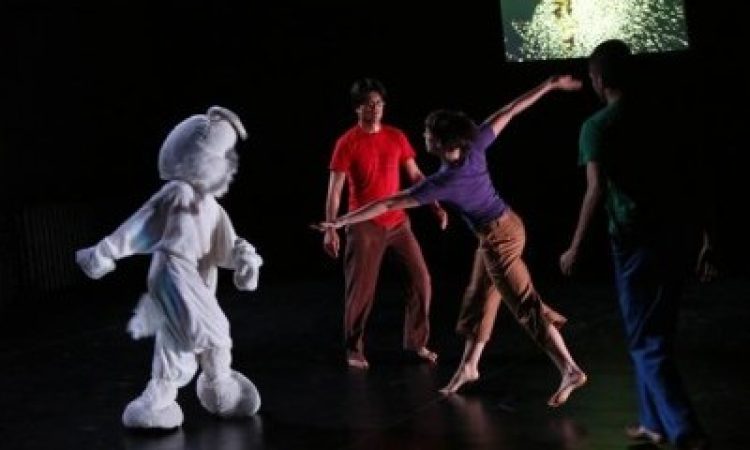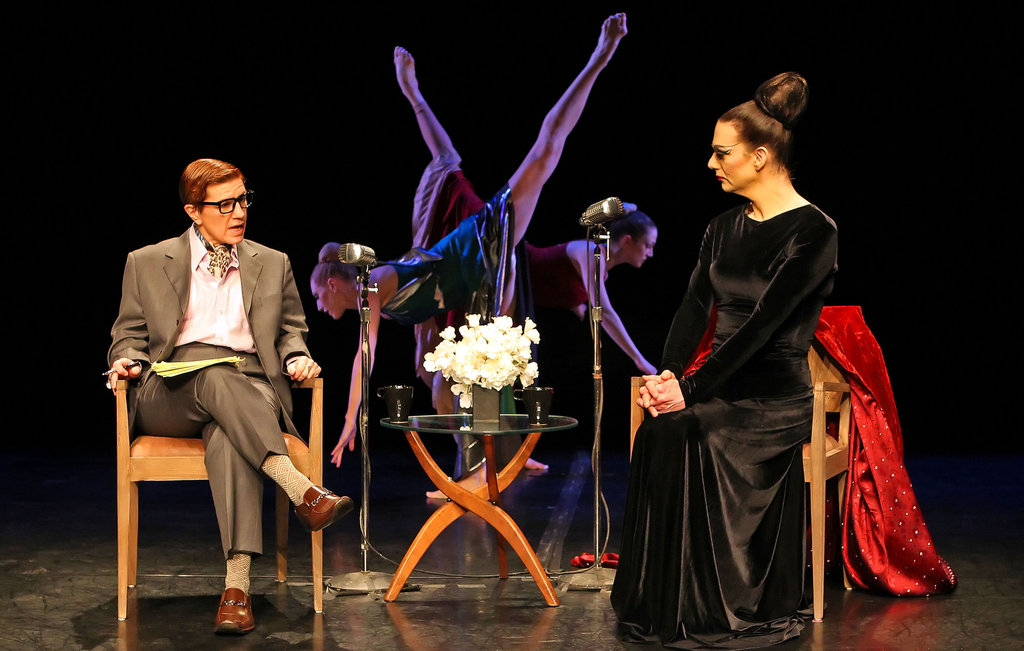We’re tired of traditional reviews for many reasons, and one is that we know an individual’s opinion of a performance isn’t really a dialogue. In the spirit of thINKingDance’s pledge to write from a place of inquisitiveness, on May 31st Kirsten and I went to see us., a double bill of work by anonymous bodies, the new collective of Jaamil Kosoko and Kate Watson-Wallace, and fidget, led by Megan Bridge and Peter Price. We’d both attended open rehearsals as well as the show, and the extended meditation on process had us thinking about elements and strategies of performance. Here is a record and an extension of our post-show discussion:
K: In the solo “other.explicit.body,” Kosoko wore a graffiti-adorned, white hooded sweat suit with sequined crotch. He was tethered to a chain, the other end fastened to a basketball wrapped in rope. A pile of books waited at the front of the stage. Cumulatively, these props told a story steeped in both African American history and stereotype. Their relationship to Kosoko’s body (moving through poses of craps shooting, vinyl scratching, and other gestural motifs) effectively evoked images ignored or minimized by those who speak of a post-racial society.
I am often left feeling, with object-based sets, that the potentials are underutilized… that they suggest much but rarely do anything. This is certainly a traditionalist take. I cannot stop hearing Anton Chekhov’s quote: “If in Act I you have a pistol hanging on the wall, then it must fire in the last act.”
How do objects affect your understanding of a piece?
D: I consider everything in sight to be intentionally placed in a performance. I don’t need all objects to be touched or used for them to resonate with me. In Kosoko and Watson-Wallace’s co-choreographed “anonymous bodies,” most or all objects (including a laptop with speakers, a box fan, and lots of extension cords) were used in some way and I still yearned for more hints about the American-flag, black & white, man/woman world in front of me. I saw a raw, d-i-y workshop, a rehearsal space. Actually, I felt the evening in its entirety erred on the side of “process as performance,” and prioritized reference, representation, and the choreography itself over performance presence. I’m reminded of John Jasperse’s Canyon, where the dancers impressively executed the myriad hops and turns, while allowing their faces to do the natural things that faces do during those physical tasks—leaving the complete result of their appearance up to chance. I wonder about both works and if that seemingly accidental quality of presence was a deliberate choice.
How do the dancers’ demeanors affect your experience of a dance?
K: It’s completely dependent on the piece. When warranted, I like high drama and melodrama, or even a shit-eating grin. On the other hand, if I am watching an intimacy or intricacy develop on stage, I don’t necessarily need the performers to acknowledge me as a witness. However, the gaze of defiant invitation (go ahead, look at me!) is one that rarely makes me feel implicated in the way I feel I am meant to. In both Kosoko’s and Bridge’s solos during us., they alternated between more seductive and nearly hostile (or at least chillingly aloof) physical attitudes towards the audience. They did this with their bodies and their eyes, but also with language.
At the end of Kosoko’s solo, he reads titles from his stack of books, throws them to the ground, vehemently repeating the phrase “I’m reading! I’m reading!” I appreciated the felt frustration (a desire for self-knowledge, artistic research, and rejection of stereotypical expectation rolled into one) but wish the piece had spent more time making the audience feel complicit in his dis-ease. Instead, I felt the audience functioned as a place-holder for society-at-large.
At the beginning of “Subject in Two Parts,” Bridge stands naked in a spotlight pulling a roll of white paper from her mouth. A recording of her sonorous voice plays. The text is funny and thoughtful, and when I listened to it again here, I laughed out loud. When Bridge came to the line: “You and I understand the No Manifesto” and began to quote Yvonne Rainer’s diatribe against drama and exposition (and many other things) traditionally found in dance performances, I wondered how many in a given audience would be familiar with that work and how much that familiarity would matter to the enjoyment of the piece. Referential text (book titles, culturally loaded quotes) can perform much like the gaze of the performer—they can invite in, accuse, or shut out the audience. Sometimes they can do all three things at once.
How do you understand the relationship of dance and text? Especially text that points to ideas and histories larger than itself?
D: I think the strategy of delivery is everything. Regardless of content, how am I receiving the words? Are they recited into the air? Am I recognized as a person in the room who can be spoken to? Or am I an onlooker to an exchange between performers? I’m interested in what the maker decides to do with the chosen material. In Part One of “Subject in Two Parts” I was most interested in the text created from recordings of the four dancers that we met in Part Two (Annie Wilson, John Luna, Lorin Lyle, and Rebecca Sloan-Potash), and its relationship to Bridge’s choreography. The voices provided specific instruction for some movements (“hips left, shrug shoulders”), fantastical narrative interpretation for others (“brush through a thick fog of moths that you gather in an imaginary hat”), and subjective description (“this move is very 1996”). This strategy worked for me, exposing the lenses through which Bridge looks at choreography herself.
Another interesting use of text was the informal exchange between Kosoko and Watson-Wallace in “anonymous bodies,” as he lay on top of her whispering about his weight, making her laugh. Kosoko’s delivery was unscripted and spontaneous, yet much of the structure and movement was pre-determined, one example of how they seemed to be working with contrast and surprise changes.
Did you notice if any changes, or segues particularly resonated with you?
K: Unison movement in postmodern work often fascinates me. Its effect is different than in ballet or modern, where matching lines are often merely a given of the aesthetic. When Kosoko and Watson-Wallace, while together on stage, transitioned from solo movement that exposed their individuality (his eloquent hands, her talent for falling) to simple unison, the facts of their bodies were exhibited for blatant, naked comparison (and I’m not referring to their bare torsos and their covered faces—or not only to that). Brave.
When Bridge changed from bombshell to crone in Part One of “Subject…”, both in costume and affect, the transition moved me. Still, I wished I had seen the transformation sans costume—to contemplate the physical changes that alter a subject’s conception of self (and outside understanding of those changes) without so many intervening layers. Throughout the evening, I was struck by how conceptual the work was and how it used a variety of media to tackle its themes, while I yearned for more thorough development of some key points. I’ve noticed this in other work that moves from idea to idea in radical fashion. I believe I’m supposed to understand this strategy as a truncation of expectation, that layering of media is part of our current reality, that seguing from one musical or visual genre to another emphasizes the cafeteria-style nature of both the world and the creation of performance. I can discuss this intellectually, but it doesn’t synch with my experience of work. Most often, I’m simply taken out of the state of mind I have cultivated to engage with live performers. I don’t want to start watching dance the way I surf radio stations.
How are you affected by jump-cuts and collage, by multiple approaches to multiple ideas addressed in quick succession?
D: I’m equally as hungry for new ways in which live movement can integrate with projected image (post-collage) as I am for work that uses technology towards a goal of minimalism. I’ve noticed a trend in contemporary performance–an obsession with layering imagery and projection. A common writing exercise is to practice writing the same story in different word counts. If you say something in 1000 words, and then cut it down to 500, how much of what you lose is crucial to the core meaning? I was reminded of this in all the work this evening, and not to say that what I saw was excessive, but rather crowded with ideas.
Which ideas, of the many presented in us. would you say were at the core of the artist’s concerns?
K: In that the evening seemed unified. Both anonymous bodies and fidget presented works in us. that were investigations of selfhood; they were pressing against and pointing at the social and cultural limitations and constructions that create identity and complicate the path toward others. Despite Bridge’s use of Annie Wilson as a jazzercising doppelganger in Part One and her self-omission from the quartet in Part Two, despite the Thing 1/Thing 2, tinsel-wigs, and black-and-white t-shirts covering Kosoko and Watson-Wallace’s faces in their duet, I experienced the evening as a series of self-portraits. The subjects were very present for me—hardly anonymous at all.
us, anonymous bodies and fidget, Christ Church Neighborhood House (New Stages for Dance Initiative), May 31-June 2, 2012. No further performances.
*Megan Bridge and Peter Price are both participants in thINKingDANCE.






